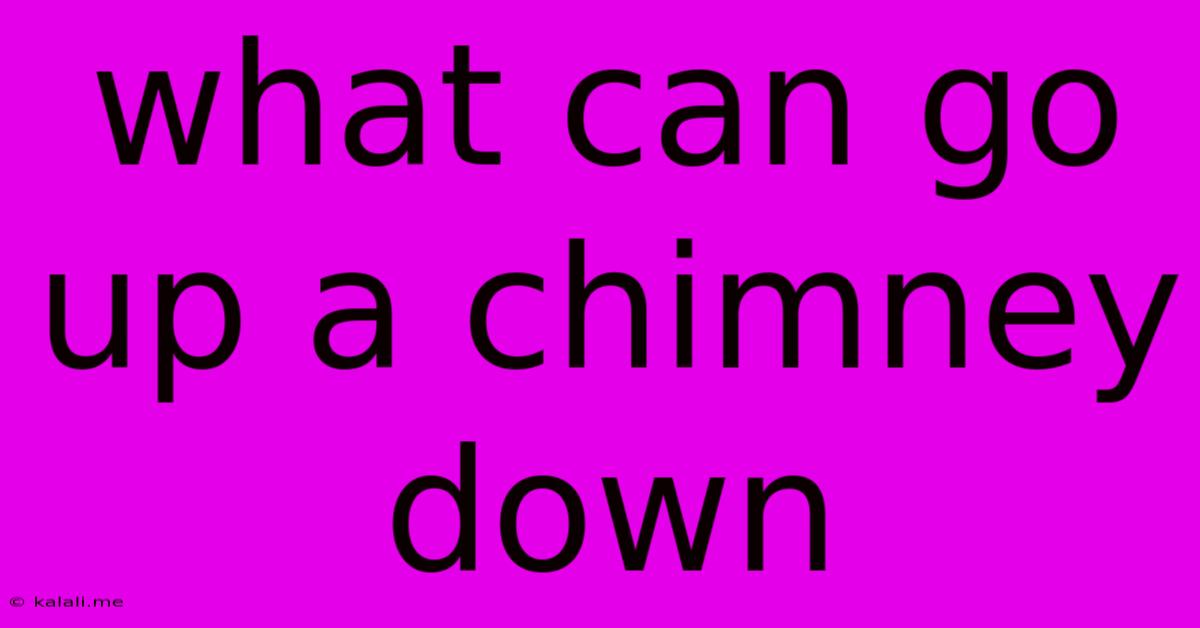What Can Go Up A Chimney Down
Kalali
May 20, 2025 · 3 min read

Table of Contents
What Can Go Up a Chimney Down? A Surprisingly Complex Question
This seemingly simple question, "What can go up a chimney down?", sparks curiosity and delves into the fascinating physics of chimneys and the unique properties of various objects. While the immediate answer might seem obvious – smoke, we'll explore a broader range of possibilities and the factors influencing their journey. This article will examine the factors affecting an object's ability to navigate a chimney, including size, shape, weight, and the chimney's design.
The most common answer, and indeed the intended purpose of a chimney, is smoke and gases from a fire. The upward draft, created by the temperature difference between the inside and outside of the chimney and influenced by wind pressure, pulls these products of combustion upwards. However, many other things, with varying degrees of success, can also make their way down a chimney.
Factors Affecting Descent
Several factors determine whether something can descend a chimney:
-
Size and Shape: A small, lightweight object, like a bird's feather, might be carried by air currents down the chimney. Conversely, a large, bulky object will likely get stuck. The internal diameter and shape of the chimney itself play a crucial role. A straight, wide chimney offers less resistance than a narrow, winding one.
-
Weight and Density: Heavier objects require a stronger downward force to overcome friction and air resistance. A small, dense object might fall more easily than a larger, lighter one of similar size.
-
Aerodynamics: The shape of the object significantly impacts its descent. A streamlined object will experience less air resistance than an irregularly shaped one. Think of the difference between a smooth stone and a crumpled piece of paper.
-
Chimney Design: The design of the chimney, including its height, flue size, and any obstructions, greatly influences the movement of objects within it. A chimney with a narrow opening or internal obstructions will likely prevent many things from passing through. The presence of a chimney cap also significantly reduces the likelihood of objects entering or falling from the chimney.
-
External Factors: Wind, rain, and even animals can influence the descent of objects down a chimney. Strong winds can create downdrafts, potentially pushing objects down.
Beyond Smoke: Potential Chimney Descendants
While smoke is the primary occupant, other things might find their way down:
- Debris: Leaves, twigs, and other small pieces of debris can be blown or fall into a chimney.
- Small Animals: Birds, squirrels, or even rats might find their way into a chimney and become stuck.
- Snow and Ice: In colder climates, snow and ice can accumulate and eventually fall down the chimney.
- Foreign Objects: Various objects might accidentally fall down a chimney, ranging from small toys to tools or building materials.
Conclusion
The seemingly simple question, "What can go up a chimney down?", reveals a surprising complexity. While smoke is the obvious answer, the ability of various objects to descend a chimney depends on a multitude of interacting factors. Understanding these factors—size, shape, weight, aerodynamics, and chimney design—helps us appreciate the subtle physics involved in this seemingly mundane process. From tiny feathers to unfortunate squirrels, the chimney holds a surprising variety of potential "descendants," highlighting the dynamic interactions between objects and the environment.
Latest Posts
Latest Posts
-
Can You Lay Vinyl Over Vinyl
May 21, 2025
-
Fallout 4 How To Get Out Of Power Armor
May 21, 2025
-
What Is Common In A Light Switch
May 21, 2025
-
Three Kobolds In A Trench Coat
May 21, 2025
-
Which Lens Can Be Turned To Change The Magnification
May 21, 2025
Related Post
Thank you for visiting our website which covers about What Can Go Up A Chimney Down . We hope the information provided has been useful to you. Feel free to contact us if you have any questions or need further assistance. See you next time and don't miss to bookmark.